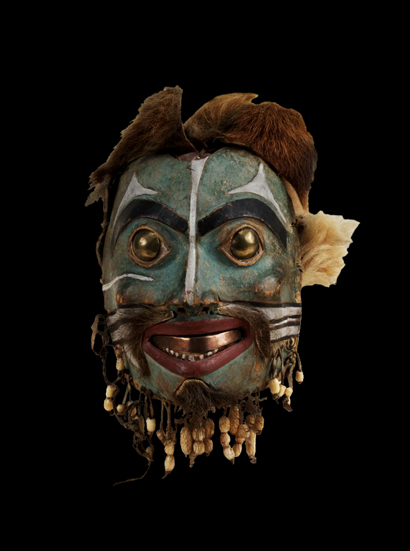In our own puerile way we sometimes take sanctuary behind impenetrable eyeglasses. For years, old and young have been wearing dark spectacles at all waking hours and in the gloomiest of places. And there are always men who rediscover another substitute for masks in shrubby beards, which curtain off precisely the part of the face that, according to Schopenhauer, “expresses morality.” Yet true masks are denied us. The only ones we are more or less familiar with are the lusterless mouth aprons of industrial workers, surgeons, bank robbers, and those less mentionable ones sported on Ku Klux Klan outings, or used by terrorists. As tools for instant self-realization they seem hopelessly blunt.

—Louis V. Shotridge (Stoowukáa, 1882-1935) was born to an influential Tlingit family in Klukwan, South East Alaska, he worked as an ethnologist for the Penn Museum. During his two decades of employment at Penn, from 1912-1932, Louis conducted four collecting expeditions in Southeast Alaska, and purchased nearly 600 Tlingit objects.—Read More:http://depepermuntjesknipper.blogspot.ca/2011/08/blog-post_5434.html
How much longer, then, do we have to wait to catch up with the noble savage, the horse-sensical peasant, and the sophisticated mummer of Renaissance times? Although more people than ever want to improve upon their face, the results hardly measure up to their expectations. Noses are straightened, teeth recapped, cheeks and double chins gathered up; yet all these makeshift repairs only distract from the radical and ultimate solution of the problem- the escape into the shelter of a “false-face.” False hair, false teeth, and glass eyes have been with us since time immemorial, and the false face can’t be far off. Such an interim face would seem to be a logical, not to say unavoidable, stage in the development of more adequate body coverings.

—A recent reproduction of a traditional Haudenosaunee
ceremonial Stone Giant or Ge-no’sqwa mask as crafted by The
Wolf Den – Native American artisan crafters.
We know from modern-day anecdotal encounter reports with purported Bigfoot-type creatures, that projectile-throwing is often witnessed.
Could the “Stone Giant” moniker also relate directly to this stone-throwing behavior many have reported in recent Sasquatch encounters?
Interestingly, many First Nation tribes describe similar woodland giants or wild men – though the names change based on tribal language… And translational meanings that remarkably echo various abilities that modern-day witnesses have attributed to Bigfoot-type creatures they have witnessed.
In Washignton state, for instance, “Skookum” or “Scoocum” are First Nation Chinook words for ‘Evil God of the Woods’. “Seatco” from the Puyallup and Nisqually languages means a ‘malevolent, larger-than-human figure that moves through the forest with stealth and quickness.’ The coastal Salish tribe has the derivative “See’atco” meaning ‘One who runs and hides.’
The Alaskan Tanaina tribe use the term “Qaxdascidi” which is the moniker for a malevolent being known for the mysterious noises it makes.—Read More:http://www.teamnesra.net/drupal/?q=node/79
It is a fact that nearly everybody, even the least observant person, has a precise, albeit mistaken, idea of what he looks like. As a rule, he or she is dissatisfied with nature’s product. they may be unsympathetic to their reflection in the mirror; they may scorn their photographic image; they may reject the portraits they or their admirers have commissioned from painters and sculptors because none of them correspond to the picture they have formed of themselves. Although the objections may not always be justified, the insistence on a super-realistic likeness is understandable. They ask for more than artistry or resemblance; i fact,resemblance may be the last thing they want. To shore up the ego, they need an icon, a holy picture of the inner self. Only a faultlessly constructed mask will meet this need- and gain their approval.

—VANCOUVER, BC.- It is said that when Surrealist André Breton first saw an indigenous mask from the Pacific Northwest , he called it “more surreal than the Surrealists.” During the 1930s and 40s, Breton and many of his Surrealist colleagues were intrigued and became avid collectors of this art and, in some cases, visitors to British Columbia and Alaska. For the first time in an exhibition, The Colour of My Dreams: The Surrealist Revolution in Art brings to light the Surrealists’ fascination with First Nations art. The Surrealists’ passion for Pacific Northwest First Nations art began in New York , where many artists fled as Europe slid from the First World War into fascism and a new conflict. Surrealists were drawn to the ‘authentic’ quality, inventiveness of form and visual brilliance of First Nations art. Some of the movement’s members collected, wrote about and even exhibited their own work alongside First Nations art from British Columbia and Alaska .
To Breton, the turn toward so-called primitive art and thought was a necessary response to the “great social and moral crisis” of the era. Breton and other Surrealists saw Europe and the West more broadly as a failed society, where the triumph of rationalism brought conflagration and vast human suffering. The Surrealists – including Max Ernst, Enrico Donati, Kurt Seligmann and Wolfgang Paalen – saw something in the Aboriginal art of the Pacific Northwest which they felt held the secret to revolutionizing what they viewed as the depleted Western imagination.—Read More:http://www.artknowledgenews.com/29_06_2011_00_15_33_vancouver_art_gallery_exhibition
An unassuming person might be content with a single mask, modeled after the most flattering photograph. A truly fastidious person might want to own and entire collection of masks, each suitable for a particular occasion, without jeopardizing their basic looks. No doubt, most people would want to look younger; a few, perhaps, older. But rare is the person who has never longed to encounter a different face in the mirror.






 COMMENTS
COMMENTS